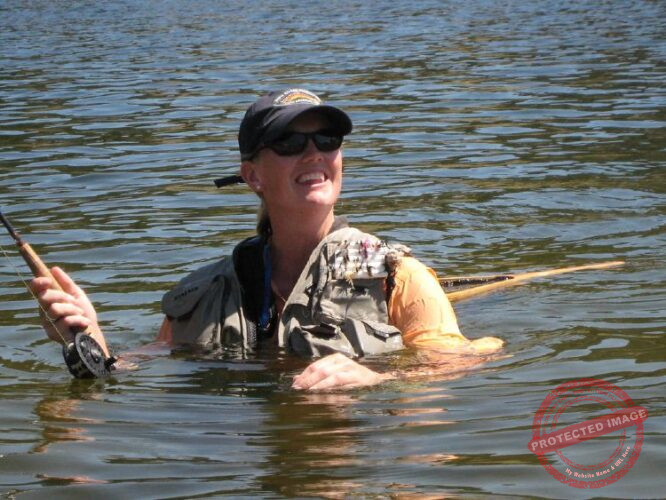You need to know wading safety tips before you go fishing. Making a mistake using waders may result in death. This is a simple truth, like it or not. Every year several people die fishing while wearing waders. They failed to understand the safety you need using waders.

Estimated Reading Time; 5 minutes
Wading Equipment for Safety
Wearing waders does impose risks while fishing. Using a few pieces of additional gear helps a lot. Always wear a floatation device. It will help you keep your head above water. Waders will fill with water pulling you down. Taking them off while submerged is very difficult. The floatation device gives you extra floatation. This makes reaching shallower water or the shore easier.
Using chest waders add a wading belt. It will not stop the water from going in but does slow down the filling process. A few seconds can make a difference. Look at it this way, less weight is easier to manage if you do fall.
Wading sticks help you balance. Plus you can feel the bottom in murky or muddy water. Do you know where the drop-offs, logs, and other hazards are located in the water? In some areas, you will not see the bottom.
Wading sticks are lightweight and attach to you with a tether. It will go downstream a couple of feet out of the way while fishing.
Safety Skills for Wading
Once you have the proper safety equipment for wading, it is time for the tips. In other words, the methods to wade safely come into play. You do not just walk into the waters without a plan or the techniques to be safe.

First, do you need to wade in on the spot? There are many places you can fish from shore or only a few feet into the water. Walking thigh-deep or more is not always something you need to do to reach the fish. You are fishing not showing off. Plus, staying out of the water keeps you from spooking the fish.
Know your limit regarding the depth. In deeper water, you start to float. This makes wading more difficult. This is another reason to only wade out far enough to reach the fish. When you are casting and catching fish. You tend to not focus on balance and keeping your feet. Learn your limit and do not exceed the limit.
Keeping Your Balance
Shuffle your feet on the bottom. This gives you a feel of the bottom. This will alert you to rocks or other tripping hazards. When lifting your foot the water can sweep the leg also. The current is stronger than many realize. Once the current sweeps a leg you are going down. Shuffling keeps your feet in contact with the bottom helping to keep your leg in place.
Position your body for the least resistance against the current. The less area hit by the current reduces the force that can knock you over. Move at angles across a current also. Crossing at a downstream angle is safer.
Plan the routes. It is easy to get into a situation where you are surrounded by deep water except the route into the spot. Look for hazards and changes in the current. A little time looking for a safe route prevents backtracking or going under. If you fall, what is the exit route? You need an easy path to land after you fall.
Watch for rising water conditions. It may have rained or a dam is releasing water upstream. If the water level is rising get out of the water as fast as possible
What to do in an Emergency
If you slip and go under, let go of your gear. It can be replaced, you cannot replace your life. Swim towards the shore. If you plan a route it will get shallow before the shore. This is when you stand up and walk. Coldwater affects your muscles. The water in many streams and rivers is cold. You can lose muscle control in a few minutes.
If being swept by the current. Place your feet downstream. You do not want your head hitting obstructions. Your legs can absorb a blow better than your head.
Take a water safety course to learn the basics. Reading and doing are two different things. Practicing makes the action more automatic. You will not have to think as much or make mistakes. The training will kick in, increasing your survival rate.
Wading Accessories at Bass Pro
Conclusion
Wading will place you in a better position for fishing. Use limits to avoid dangerous situations. Maintain a good balance and footing. Plan a safe route in the water. Know what to do in the event of an accident. Use the safety gear to reduce risks. Wading safety tips may save your life. Do not ignore safety while in or on the water.
